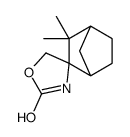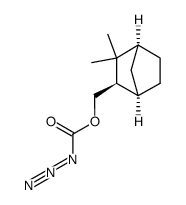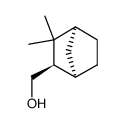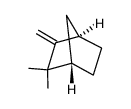155323-17-4
| Name | (2S)-3,3-Dimethyl-2'H-spiro[bicyclo[2.2.1]heptane-2,4'-[1,3]oxazo lidin]-2'-one |
|---|---|
| Synonyms |
7|A-Spironolactone
(7|A,17|A)-7-(Acetylthio)-17-hydroxy-3-oxopregn-4-ene-21-carboxylic Acid |A-Lactone 17-Hydroxy-7|A-mercapto-3-oxo-17|A-pregn-4-ene-21-carboxylic Acid |A-Lactone Acetate 3'-(3-Oxo-7|A-acetylthio-17|A-hydroxyandrost-4-en-17|A-yl)-propionic Acid Lactone 7|A-(Acetylthio)-17|A-hydroxy-3-oxopregn-4-ene-21-carboxylic Acid |A-Lactone Spironolacton spiro-oxazolidin-2-one (5S)-4-aza-2-oxa-6,6-dimethyl-7,10-methylene-5-spiro<4.5>decan-3-one |
| Density | 1.16g/cm3 |
|---|---|
| Boiling Point | 375.2ºC at 760mmHg |
| Melting Point | 227-231ºC |
| Molecular Formula | C11H17NO2 |
| Molecular Weight | 195.25800 |
| Flash Point | 180.7ºC |
| Exact Mass | 195.12600 |
| PSA | 41.82000 |
| LogP | 1.56110 |
| Vapour Pressure | 7.9E-06mmHg at 25°C |
| Index of Refraction | 1.538 |
Synonym: 5S-4-Aza-2-Oxa-6,6-Dimethyl-7,10-Methylene-5-Spiro[4.5]decan-3-one. SECTION 2 - COMPOSITION, INFORMATION ON INGREDIENTS
Risk Phrases: None Listed. SECTION 3 - HAZARDS IDENTIFICATION EMERGENCY OVERVIEW The toxicological properties of this material have not been fully investigated. Potential Health Effects Eye: May cause eye irritation. Skin: May cause skin irritation.
Ingestion: May cause irritation of the digestive tract. The toxicological properties of this substance have not been fully investigated. Inhalation: May cause respiratory tract irritation. The toxicological properties of this substance have not been fully investigated. Chronic: No information found. SECTION 4 - FIRST AID MEASURES Eyes: Flush eyes with plenty of water for at least 15 minutes, occasionally lifting the upper and lower eyelids. Get medical aid. Skin: Get medical aid. Flush skin with plenty of water for at least 15 minutes while removing contaminated clothing and shoes. Wash clothing before reuse. Ingestion: Never give anything by mouth to an unconscious person. Get medical aid. Do NOT induce vomiting. If conscious and alert, rinse mouth and drink 2-4 cupfuls of milk or water. Inhalation: Remove from exposure and move to fresh air immediately. If not breathing, give artificial respiration. If breathing is difficult, give oxygen. Get medical aid. Notes to Physician: SECTION 5 - FIRE FIGHTING MEASURES General Information: As in any fire, wear a self-contained breathing apparatus in pressure-demand, MSHA/NIOSH (approved or equivalent), and full protective gear. During a fire, irritating and highly toxic gases may be generated by thermal decomposition or combustion. Extinguishing Media: Use agent most appropriate to extinguish fire. Use water spray, dry chemical, carbon dioxide, or appropriate foam. SECTION 6 - ACCIDENTAL RELEASE MEASURES General Information: Use proper personal protective equipment as indicated in Section 8. Spills/Leaks: Vacuum or sweep up material and place into a suitable disposal container. Clean up spills immediately, observing precautions in the Protective Equipment section. Avoid generating dusty conditions. Provide ventilation. SECTION 7 - HANDLING and STORAGE Handling: Wash thoroughly after handling. Use with adequate ventilation. Minimize dust generation and accumulation. Avoid contact with eyes, skin, and clothing. Keep container tightly closed. Avoid ingestion and inhalation. Storage: Store in a tightly closed container. Store in a cool, dry, well-ventilated area away from incompatible substances. SECTION 8 - EXPOSURE CONTROLS, PERSONAL PROTECTION Engineering Controls: Facilities storing or utilizing this material should be equipped with an eyewash facility and a safety shower. Use adequate ventilation to keep airborne concentrations low. Exposure Limits CAS# 155323-17-4: Personal Protective Equipment Eyes: Wear appropriate protective eyeglasses or chemical safety goggles as described by OSHA's eye and face protection regulations in 29 CFR 1910.133 or European Standard EN166. Skin: Wear appropriate protective gloves to prevent skin exposure. Clothing: Wear appropriate protective clothing to prevent skin exposure. Respirators: A respiratory protection program that meets OSHA's 29 CFR 1910.134 and ANSI Z88.2 requirements or European Standard EN 149 must be followed whenever workplace conditions warrant respirator use. SECTION 9 - PHYSICAL AND CHEMICAL PROPERTIES Physical State: Powder Color: white Odor: none reported pH: Not available. Vapor Pressure: Not available. Viscosity: Not available. Boiling Point: Not available. Freezing/Melting Point: 223 - 224 deg C Autoignition Temperature: Not applicable. Flash Point: Not applicable. Explosion Limits, lower: Not available. Explosion Limits, upper: Not available. Decomposition Temperature: Solubility in water: Specific Gravity/Density: Molecular Formula: C11H17NO2 Molecular Weight: 195.26 SECTION 10 - STABILITY AND REACTIVITY Chemical Stability: Stable at room temperature in closed containers under normal storage and handling conditions. Conditions to Avoid: Incompatible materials, dust generation, excess heat. Incompatibilities with Other Materials: Oxidizing agents. Hazardous Decomposition Products: Carbon monoxide, irritating and toxic fumes and gases, carbon dioxide. Hazardous Polymerization: Has not been reported SECTION 11 - TOXICOLOGICAL INFORMATION RTECS#: CAS# 155323-17-4 unlisted. LD50/LC50: Not available. Carcinogenicity: (+)-Chiracamphox - Not listed by ACGIH, IARC, or NTP. SECTION 12 - ECOLOGICAL INFORMATION SECTION 13 - DISPOSAL CONSIDERATIONS Dispose of in a manner consistent with federal, state, and local regulations. SECTION 14 - TRANSPORT INFORMATION IATA Not regulated as a hazardous material. IMO Not regulated as a hazardous material. RID/ADR Not regulated as a hazardous material. SECTION 15 - REGULATORY INFORMATION European/International Regulations European Labeling in Accordance with EC Directives Hazard Symbols: Not available. Risk Phrases: Safety Phrases: S 24/25 Avoid contact with skin and eyes. S 28A After contact with skin, wash immediately with plenty of water. S 37 Wear suitable gloves. S 45 In case of accident or if you feel unwell, seek medical advice immediately (show the label where possible). WGK (Water Danger/Protection) CAS# 155323-17-4: No information available. Canada None of the chemicals in this product are listed on the DSL/NDSL list. CAS# 155323-17-4 is not listed on Canada's Ingredient Disclosure List. US FEDERAL TSCA CAS# 155323-17-4 is not listed on the TSCA inventory. It is for research and development use only. SECTION 16 - ADDITIONAL INFORMATION MSDS Creation Date: 9/02/1997 Revision #6 Date: 3/18/2003 The information above is believed to be accurate and represents the best information currently available to us. However, we make no warranty of merchantability or any other warranty, express or implied, with respect to such information, and we assume no liability resulting from its use. Users should make their own investigations to determine the suitability of the information for their particular purposes. In no way shall the company be liable for any claims, losses, or damages of any third party or for lost profits or any special, indirect, incidental, consequential or exemplary damages, howsoever arising, even if the company has been advised of the possibility of such damages. SECTION 16 - ADDITIONAL INFORMATION N/A |
| Safety Phrases | 22-24/25 |
|---|---|
| WGK Germany | 3 |
|
~67% 
155323-17-4 |
| Literature: Banks, Malcolm R.; Blake, Alexander J.; Brown, Angus R.; Cadogan, J. I. G.; Gaur, Suneel; et al. Tetrahedron Letters, 1994 , vol. 35, # 3 p. 489 - 492 |
|
~% 
155323-17-4 |
| Literature: Banks, Malcolm R.; Blake, Alexander J.; Brown, Angus R.; Cadogan, J. I. G.; Gaur, Suneel; et al. Tetrahedron Letters, 1994 , vol. 35, # 3 p. 489 - 492 |
|
~% 
155323-17-4 |
| Literature: Banks, Malcolm R.; Cadogan, J. I. G.; Gosney, Ian; Grant, Keith J.; Hodgson, Philip K. G.; Thorburn, Paul Heterocycles, 1994 , vol. 37, # 1 p. 199 - 206 |
| Precursor 2 | |
|---|---|
| DownStream 0 | |


